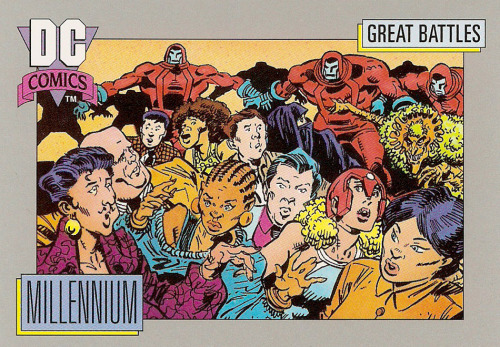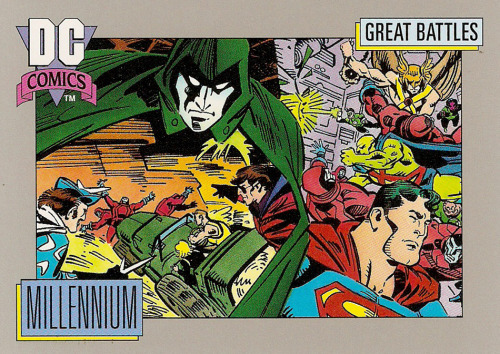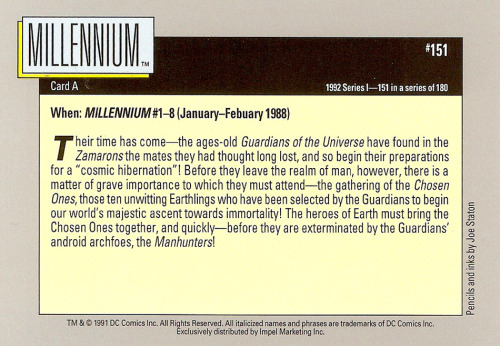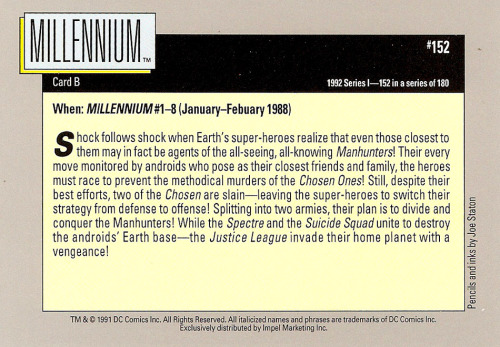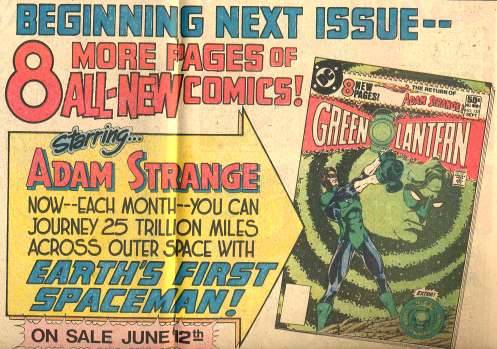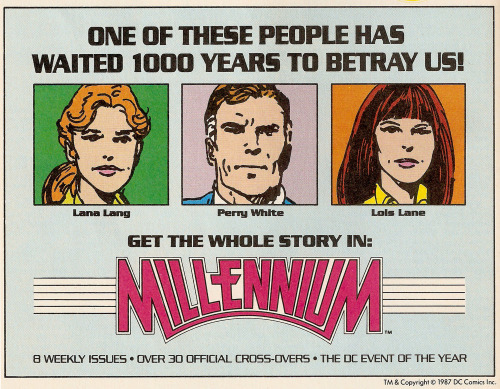#staton
IMPEL DC Cosmic Cards recounts the ballad of the Millennium saga
As a child of the 80s, I was a teen of the 90s. And as a teen of the 90s (living in middle-class suburbia), I had way more disposable income than any 14 year-old had a right to - so I spent my money on these: IMPEL’s DC COSMIC CARDS (INAUGURAL EDITION) released in 1991. This was no friviolous expenditure, you need to understand. This was about a decade before every household in North America would have access to the internet and if you wanted to know about a specific comic book character you either needed to A) own the comic book or B) have a really knowledgable friend who could tell you all about them. DC COSMIC CARDS were the cheaper, more convenient solution. (Actually, the most effective solution would be access to all six volumes of Who’s Who in the DC Universe - but let’s be reasonable here.)
In this example, some poor copy-editor needed to find a way to make Millennium sound exciting in three pragraphs or less. This is rather amusing, since Millennium is almost universally panned as one of the worst DC cross-over events to come out of the 80s. (I actually don’t agree with that - as a passive Green Lantern Corps fan, I find that the event has it’s own unique merits). The art on the front of the card doesn’t match up with the summary text on the back, and probably wouldn’t have really meant anything to anyone unless they’d read all 8 issues (and corresponding tie-ins) of the Millennium event first-hand. This particular 3-set of cards were illustrated by Joe Staton - the very artist who illustrated 1988’s Millennium event - so, that’s a nice touch of authenticity. I could be wrong, but I’m pretty sure this artwork was created specifically for these cards.
On card #1 we have the team that will eventually become The New Guardians surrounded by Manhunters. OK - check. Card #2 we have the Suicide Squad, the Justice League, some Green Lanternsandthe Spectre beating up on more Manhunters. The only recognizable Suicide Squadder on the card in Captain Boomerang - I had to really squint to recognize the Privateer and the other two driving the jeep (who’s names escape me at the moment). Card #3 is the real pièce de résistance: Guy Gardner cutting the head off of a Manhunter with a green knife construct. (Thankfully the Manhunters were robots, so this doesn’t really constitute as violence.) Staton would be the regular artist for the first 14 issues of Guy Gardner’s 1992 ongoing series (as well as it’s 3-issue Guy Gardner Reborn prequel) - so this is fitting. Guy Gardner rocketed to fame in the mid-to-late 80s as the anti-hero of the GLC and Justice League, and thus made him a “cool” character and I remember prizing anything I owned featuring Guy Gardner, so this card would not have been an exception.
It’s noteworthy that the IMPEL Cosmic Cards collection contained NO Batman-related characters (unless you count Nightwing - who was a major player in the Teen Titans at the time), but I’m sure we’ll delve into that some other time.
Post link
There’s been an unexpected hiatus in new posts due to… well… summer.
Get out there and try to enjoy yourselves. We’ll be back with new posts as soon as the miserable Canadian weather returns.
scene of the Green Lantern Corps chillin’ in the pool from Millennium #1 (1988). Illustrated by Joe Staton.
Post link
Green Lantern v2 (Marv Wolfman’s run)
AfterGreen Arrow was evicted from the series,Green Lantern v2 began to get a whole lot better. Green Arrow already had a long residency as a feature in World Finest v1 since 1977 - so don’t feel too sorry for him. Denny O'Neil, who had been writing Green Lantern since it’s DC Explosion revival in 1976 (GreenLantern v2 #90), wrote another six issues after Green Arrow had been booted out of the series and then left DC to work for Marvel comics in 1980. In his last six issues of Green Lantern,O'Neil managed to return Hal Jordan to his roots - Carol Ferris was re-instated as a potential love interest, Thomas Kalmaku (AKA Pieface) was back to being his sidekick, and Hal Jordan was once again a test pilot for Ferris Airlines. Another element O'Neil brought back was Hal Jordan’s arch-nemesis Sinestro - most of O'Neil’s final six issues involved a running plot of Hal Jordan battling Sinestro (with a dash of classic Green Lantern villains Hector Hammond and Star Sapphire thrown in for good measure). Whether it was a good time for O'Neil to cut and run from DC was up for debate as he had previously killed off Batwoman (Kathy Kane) in the pages ofDetective Comics that very same summer.
Green Lantern v2 issues #130 to #132 had guest writers. Bob Rozakis wrote issue #130, Mike W Barr wrote #131 and Paul Kupperberg wrote issue #132. What’s noteworthy about these issues is that we’re starting to see more of Green Lantern’s classical villains appear (Sonar and Evil Star). Another interesting development was occurring: now that Green Lantern wasn’t tethered to Green Arrow, there was more room to explore the Green Lantern mythos, and that included the Green Lantern Corps. The Green Lantern Corps played a prominent role in a few of O'Neil’s post-Green Arrow issues, but more importantly, the Green Lantern Corps received a back-up feature in Green Lantern v2 #130. Written by Bob Toomey and drawn by Alex Saviuk, the Green Lantern Corps stories were some previously completed but unpublished work that finally had a chance to be printed. Fans loved the concept and demanded more Green Lantern Corps stories. [more about that later]
Green Lantern v2 #132 saw a price jump from forty to fifty cents - this involved an extra eight pages of story and this is when Adam Strange became a back-up feature. Written by Jack C Harris and illustrated by Rodin L Rodriguez, the Adam Strange back-ups would run until Green Lantern v2 #147 (but not before switching creative teams to Laurie Sutton as writer and Carmine Infantino as artist). There would be another price increase to 60 cents by issue #144, for an extra 2 pages of story in 1981.
Marv Wolfman became the regular writer for Green Lantern v2 at issue #133. DC comics acquired the talented Mr. Wolfman after he had just left Marvel comics due to a dispute with Marvel’s editor-in-chief, Jim Shooter. Building on the momentum of O'Neil’s ‘back-to-basics’ approach for Hal Jordan, the first thing Wolfman did when he started writing Green Lantern was to shine up all of Hal Jordan’s relationships that had gotten a little vague over the last 20 years. He aimed to bring Hal and Carol Ferris back together, get all the characters set up, give Hal some new friends and create a new support cast as a launching pad for more stories. Wolfman also continued with the hit parade of classic Green Lantern villain appearances: Dr Polaris, Goldface, and Black Hand all appeared during Wolfman’s run. Interesting to note that Wolfman tried to make Goldface THE arch-foe of Hal Jordan. He wanted a foe whose super-powers were less important than the threat of his very existence. Wolfman also brought back an old one-time Green Lantern foe, The Tattooed Man, only to have him killed off*. This was possibly one of the first times a Green Lantern foe had been killed off - fans were a little annoyed by that little stunt. Wolfman explained that the Tattooed Man was killed off because his powers weren’t unique. Wolfman introduces the Omega Men (and the Vegan Star System) in Green Lantern v2 #141 (this would spin-off into it’s own series).
Long-time readers will most likely remember Wolfman as the writer who 'humanized’ Hal Jordan. Wolfman believed that what made a series work were the characters - if they are interesting and if their problems are engrossing. He believed that a blend of good stories, good characters and situations, coupled with interesting action sequences was the key to a successful series. Wolfman and his editors (Jack C Harris,Len Wein,Cary BurkettandDave Manak) decided to infuse a stronger personality in Hal Jordan (more so than done in the past). Wolfman really tried to get to the 'root’ of Hal Jordan. Another interesting plot element that Wolfman likes to explore is the masked crime fighter versus the legal system angle (as seen in Green Lantern v2 #145 - #146) - Wolfman would further explore this idea in his 1983Vigilanteseries.
As you are also probably well aware, Marv Wolfman was the mastermind behind the Crisis On Infinite Earths event - a grand gesture intended to make DC’s continuity way less confusing. You begin to recognize that Wolfman was making a concentrated effort to establish a DC-wide continuity in his Green Lantern v2run:
1. Re-introduction of older characters to a modern audience. These include Space Ranger from Green Lantern v2 #136 - #137, and Bruce Gordon/Eclipso from Green Lantern v2 #136 - #138.Wolfman is a stickler for cohesion, and demonstrating that characters from the old DC anthologies were still an active part of DC continuity is a major part of crafting a sense that everything is tied together and occupying the same universe.
2. Integrating characters from another title into the storyline. The Gordanians make an appearance and the H.I.V.E. are mentioned. Both sets of characters are from the New Teen Titans series that Wolfman was also writing at the same time. Most fans don’t realize this, but Wolfman was writing New Teen Titans,Action ComicsandAdventure Comics while he was writing Green Lantern v2. Integrating characters from another series as a way to create cohesion within the DC universe.
3. Answers the age-old question: if Hal Jordan was facing a global threat, where were all the other heroes? During Green Lantern’s battle with Eclipso, Wolfman made a point to show the rest of the Justice League’s efforts in combating the threat. Trying to keep the idea that although all of these characters occupy different comic book titles, they all occupy the same planet.
4.Wolfman addresses problems about Green Lantern v2 not meshing with prior DC history (case in point: Green Lantern v2 #136-#137 contradicts 1978’s Showcase #100).Wolfman explains that someday soon they will straighten all of that out (pre-lude to Crisis on Infinite Earths?).
5.Wolfman later incorporates some pre-existing Guardians of OA history into Crisis on Infinite Earths. The scene where a rogue Guardian (Krona) tries to view the creation of the universe thus unleashing the anti-monitor already existed prior to Crisis on Infinite Earths being written - Wolfman just retconned it slightly without altering anything major to meet the story’s needs. The Guardians of OA would come to play a major part in post-Crisis DC continuity (see: Millennium event)
The last issue of Wolfman’sGreen Lantern v2 run was issue #151 - after which he plotted issues #152 and #153 (while Gary CohnandDan Mishkin scripted) and became co-editor with Ernie Colon shortly thereafter. Wolfman dropped the series because he was too busy with the Teen Titans,Action Comicsandthe new horror/adventure series that he was planning.Wolfman left the series sending Hal Jordan in a new sci-fi direction (banished from earth by the Guardians of OA), his view was to get Hal off of Earth - Wolfman reasoned that Hal should be the Green Lantern of his entire space sector, not just the planet Earth. Green Lantern v2 #155 was the last issue pencilled by Joe Staton(Keith Pollard took over pencilling chores afterwards) - Staton would return as regular Green Lantern penciller two years later.
What was Wolfman’s impact on Green Lantern during his two year run? Green Lantern’s sales were very good when Wolfman took over, but dipped quite badly after the Space Ranger story arc. Sales of the series started climbing again after the introduction of the Omega Men. Sales for Green Lantern v2 were really high as of issue #147, so Wolfman left the series in pretty good health when Mike W Barr took over as regular writer.
WhileWolfman’s excellent writing, characterization and new direction for the series during this time period is definitely worth noting, I’d say the biggest development during this two year period was the Green Lantern Corps taking a more prominent role in the Green Lantern mythos. The Green Lantern Corps appeared in Green Lantern v2 #127(whileO'Neil was writing) and there seemed to be a pretty good response from the fans, so the Corps started to get a little bit more exposure in the series.
In 1981, a 3 issue mini-series written by Len WeinandMike W Barr was published titled Tales of the Green Lantern Corps that mainly focused on the Corps as a single unit (this included Hal Jordan). Various Green Lantern stories in the past had featured alien Green Lanterns in one-off team-up stories, but suddenly it was made aware that the Green Lantern Corps consisted of a diverse race of aliens with it’s own culture. The critical and sales impact of the Tales of Green Lantern Corps mini-series had a notable impact on Green Lantern v2 - lead stories began to have more alien Green Lantern Corps members and, as a result, more Green Lantern Corps members (Ch'P, Salaak, Arisia, Galius Zed, etc…) were introduced in the pages of Green Lantern v2. The Green Lantern Corps were so popular with the readers that the Adam Strange back-up feature was removed (#148) in favor of more Green Lantern Corps back-up features appearing instead. Paul Kupperberg (who was fresh on his stint from DC’s Ghosts) was writing said back-up tales and Don Newtonand/orCarmine Infantino was illustrating. Incedentaly, Kupperberg/Infantino also worked together on 1982’s New Adventures of Supergirlseries.
*In possibly THE most obscure spin-off ever, the Tattooed Man received his own Vertigo mini-series in 1993: Skin Graft: The Adventures of a Tattooed Man written by Jerry Prosser and illustrated by Warren Pleece.
Post link
Millennium cross-over event
Millennium was DC’s third inter-company cross-over (preceded by Crisis on Infinite EarthsandLEGENDS, respectively). If the goal of Crisis on Infinite Earths was to sort out its continuity issues and the goal of LEGENDS was to re-establish the DCU, then I’d theorize that the goal of Millennium was to flesh out the characters and relationships within the DC universe.
The entire 56-issue Millennium event took place over a two month publication period (Crisis took about a year and LEGENDS took 7 to 8 months). Millennium itself was an eight-issue mini-series released on a weekly basis (each issue labelled as ‘week 1’, 'week 2’, etc…) that acted as a overview of the event - readers were encouraged to read all of the tie-in issues that ran through the DC titles to understand what was going on between the weekly installments of Millennium. This cross-over event was all-encompassing and seemed to involve all of the most popular DC titles at the time (ex: all Batman titles, all Supermantitles,Flash,Wonder Woman, whatever series Green Lantern was starring in, Legion of Super-Heroes, etc). Mega cross-overs involving all titles were still a relatively new gimmick at this point in time and DC was still testing the waters.
The Millennium mini-series was handled by the creative team of Steve Englehart,Joe StatonandIan Gibson. Prior to being assigned Millennium,EnglehartandStaton had raised the sales of tepid selling Green Lantern v2 to heights previously unseen in the publication’s history. Actually, the whole concept of Millennium was inspired by a plot device Englehart had used in Green Lantern v2 #200 (1986) in which the Guardians task the Green Lantern Corps to protect Earth because it would be an ideal breeding ground for immortals in the next thousand years. The Millennium storyline was centered around the Guardians of the Universe’s efforts to evolve human beings to the next level, and the Manhunters who were trying to oppose them. As it happens, Englehart co-created the Manhunters and introduced them to the DC Universe back in Justice League of America #140 (1977). The Guardians of the Universe (said to be originally modeled after David-Ben Gurion) were originally created by John BroomeandGil Kane, but it was Englehart who (while writing Green Lantern) had managed to tie the Guardians in with a mega cross-over event (going so far as to reveal the Guardians as the original cause of the Crisis) thus solidifying their involvement in all things cosmic in the DC Universe. [I remember hearing a rumor that editor Andy Helfer (who helped coordinate with the other DC writers while Englehart worked from his California home) retired from comics after this cross-over event due to all of the stress involved (he also edited the LEGENDS cross-over). However, I know that Helfer went on to edit several more DC titles before becoming editor of Paradox Press, so I don’t think there’s any truth to that rumor.]
If one were to breakdown the plot of Millennium into 4 acts, they would be:
- Act 1: heroes discover there are traitors/Manhunters among them
- Act 2: heroes rally and attack Manhunters’ earth forces
- Act 3: heroes attack Manhunters in space
- Act 4: heroes attack Manhunter HQ at center of world
It was the first act that caused the biggest commotion with the writers at DC comics - not only were they mandated by the 'higher ups’ at DC to work the Millennium event into their storyline, but they also had to select a supporting character to be revealed as a Manhunter in disguise. As you can see in the above ads, the whole idea of who will be revealed as a traitor was a major part of the marketing campaign. To their credit, it was left up to the writers to decide who the traitor would be. Some writers really went out of their way to make their series work with Millennium(ex:John Byrne who seamlessly integrated the Millennium event into his 1988 World of Smallville Superman origin retcon mini-series, Roy Thomas who took the opportunity to retcon the origins of the Dan Richards and Paul Kirk Manhunters in a way that was consistent with the Millennium storyline, and Paul Levitz who probably received a lot of hate mail from fans when he revealed who the Manhunter in the Legion of Super-Heroes was), and other writers easily modified their story lines so that it had something to do with Millennium(ex:George Perez and his “Challenge of the Gods” in Wonder Woman,Mike Baron reveals the traitor in Flash in a way that would make logical sense in hindsight), while other writers seemed to glaze over it completely (ex: Keith Giffen’sJustice League International traitor is quickly replaced with a carbon-copy duplicate and has no effect on the series). A few characters appeared for the first time during these tie-ins, but were not directly involved with Millennium - these included G'Nort (Justice League International #10) and the post-Crisis Toyman (Superman #13). The FirestormMillennium tie-ins mainly involved Firestorm dealing with the evolution of his powers.
I previously mentioned that all of the major DC titles were involved in this cross-over, however a few were actually left out. These included:
- Swamp Thing,Vigilanteandthe Question (Because they were 'mature reader’ titles, and DC didn’t think it was wise to include them in a cross-over event that was targeted to general audience members. Yet The Spectre was included? Interesting.)
- The Teen Titans (At the time they were doing that 'direct edition/newsstand edition’ thing where one set of stories would have to be set 1 year in the future. Just a major continuity headache to figure out.)
- The Warlord (DC had promised fans that after LEGENDS they would never do another Warlord/DCU cross-over story due to negative fan reaction)
Millennium led to the creation of two new spin-off titles in 1988: the New GuardiansandJohn Ostrander’s the Manhunter. Likewise, Millennium saw the end of the Outsiders v1andBooster Gold v1, but the sales on these books were already dwindling - so in essence Millennium was just a convenient plot device they could use to wrap things up. (Blue Beetle would also be cancelled shortly after his Millenniumtie-in.)
Another thing that Millennium is infamous for is featuring the first gay super hero in the DC universe. I say 'infamous’ because the character is so poorly-written and stereotypical that he may have set the gay movement back 10 years. Extraño was a Peruvian magician who was empowered by the Guardians and made to become a member of the New Guardians. Englehart was panned by the gay community for his portrayal of the offensively flamboyant character, often receiving mail that went along the lines of “I am gay and that character should in no way shape or form act as a reference of what a gay person is like”. You need to remember that Englehart (for whatever reason) was not allowed to come out and say the character was gay, so he had to push the theatrics to the extreme so that the readers could pick up on it. For all it’s worth, Englehart really tried to introduce a gay super-hero into DC comics.(more on this some other time)
AfterMillennium, DC comics wanted to move Green Lantern to the new Action Comics weekly series (in an effort to generate interest in the new Action Comicsformat).EnglehartandStaton declined, since they didn’t want to be confined to a 7-page weekly format. Green Lantern Corps (the book EnglehartandStaton were working on) lasted a few more issues afterMillennium and was then cancelled.
I really enjoyed this cross-over event. Over time I have managed to find all 47 tie-in issues (discount bin hunting at comic book shops) and I absolutely do not regret it. This was the absolute BEST TIME EVER to read DC comics: we had John Ostrander’sSuicide Squad, Batman was teamed with Jason Todd Robin, the Superman books had just been rebooted by Byrne,Thomas was writing Young All-StarsANDInfinity Inc., Wally West Flash had just taken over Barry Allen’s title, Keith Giffen’s Justice League was at some of it’s best moments, George Perez’Wonder Woman was just revving up and the Legion of Super-Heroes was going strong. DeMatteis’ new Dr FateandMike Grell’sGreen Arrow even make a few appearances. I especially liked the Secret Origins tie-ins (re-explained and retconned numerous origins to characters in a way that seemed to flow effortlessly with Millennium and the new DCU) and Teen Titans Spotlight issues (which took the time to feature characters that didn’t really fit anywhere else but were important to the story regardless). I really like how this cross-over was able to incorporate a lot of elements from the Crisison Infinite Earths while still bringing something new to the table. I didn’t get why DC decided to expose all of the Manhunter traitors in the first issue of Millennium - I think that had they let the suspense build up for longer the result could’ve been more entertaining.
This event deals heavily with the idea of humanity evolving, which apparently is a theme Englehart likes to explore. Astute comic readers have drawn parallels between MillenniumandEnglehart’sCelestial Madonna storyline that ran in various Marvel comics’ Avengers books from 1974 to 1975.
*Dan Richards was the alter-ego of a Quality Comics character called the Manhunter first introduced in 1942. Coincidentally, DC also had a character called the Manhunter (alter ego Paul Kirk) who debuted one month after Dan Richards did in 1942. DC bought the rights to the Dan Richards Manhunter in 1956 when Quality Comics went bankrupt.
Post link

